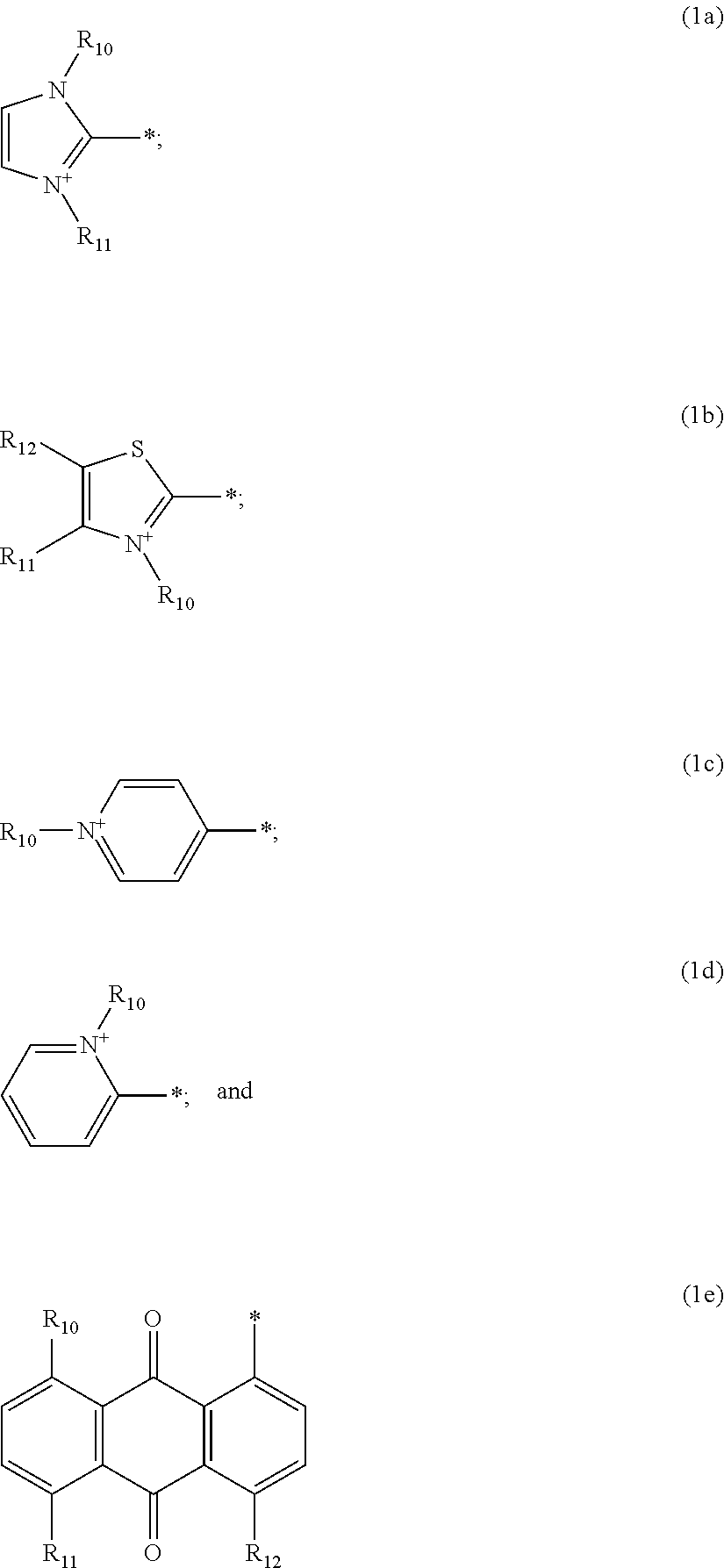Cationic Direct Dyes
- Summary
- Abstract
- Description
- Claims
- Application Information
AI Technical Summary
Problems solved by technology
Method used
Image
Examples
Example
Example 1: (E)-1,3-bis(3-aminopropyl)-2-((4-dimethylamino)phenyl)diazenyl)-1H-imidazol-3-ium bromide dihydrochloride
[0186]
Example 1
[0187]
a) Step 1: 4-[(E)-1H-imidazol-2-ylazo]-N,N-dimethyl-aniline
[0188]
[0189]20 g (0.105 mol) 2-((4-fluorphenyl)diazenyl)-1H-imidazole prepared according to literature (V. Eliu et al, WO2007025889) were suspended in 60 ml dimethylsulfoxide. To this suspension, 60 ml (0.532 mol) of an aqueous solution (40%) of dimethylamine was added within 10 minutes. The product mixture was heated to 80° C. and stirred at this temperature for 6 hours. Then the reaction solution was slowly cooled down to 20° C. A brown suspension was formed. The precipitate was filtered-off, washed with distilled water and dried at 40° C. at high vacuum.
[0190]Yield: 14 g, yellow solid.
[0191]1H NMR (DMSO-d6): δ=3.20 (s; 6H; 2×H3), 6.80, 7.20 and 7.78 (each m; 2H; Aryl-H), 12.5 (s, br, NH) ppm.
b) Step 2: 2-((E)-(4-(dimethylamino)phenyl)diazenyl)-1,3-bis(3-((((1,1-dimethylethyl)oxy)carbonyl...
Example
Example 2: (E)-1,3-bis-(3-ammoniopropyl)-2-((4-(dipentylamino)phenyl)diazenyl)-1H-imidazol-3-ium trifluoracetate
[0201]
Synthesis Scheme of Example 2
[0202]
a) Step 1 1,3-bis(3-(1,3-dioxo-1,3-dihydro-2H-isoindole-2-yl)propyl)-2-((E)-(4-fluorophenyl)diazenyl)-1H-imidazol-3-ium bromide
[0203]
[0204]To a mixture of 3.8 g (20 mmol) 2-((4-fluorphenyl)diazenyl)-1H-imidazole and 3.4 g (40 mmol) sodium bicarbonate in 80 ml of acetonitrile was added 16.1 g (60 mmol) N-(3-bromopropyl)phthalimide. The mixture was refluxed for 60 hours. The formed precipitate was removed by filtration and the filtrate was concentrated under reduced pressure. The resulting residue was applied to flash chromatography to yield intermediate as brown solid.
[0205]Yield: 4.2 g (33%).
b) Step 2: 1,3-bis(3-(1,3-dioxo-1,3-dihydro-2H-isoindol-2-yl)propyl)-2-((E)-(4-dipentylaminophenyl)diazenyl)-1H-imidazol-3-ium bromide
[0206]
Example
[0207]To a mixture of 1.94 g (3 mmol) crude intermediate from example 2a), 4.5 g (1.5 mmol) sodium bicarbonate in 2.5 ml of acetone and 10 ml of water was added 0.566 g (3.6 mmol) dipentylamine. The mixture was stirred at 20° C. for 3 hours. The mixture was diluted with water and extracted with dichloromethane. The crude product was purified with flash chromatography.
c) Final Step
[0208]2.3 g (2.94 mmol) was dissolved in isopropanol and 1.8 g (29.4 mmol) ethylenediamine was added. The mixture was refluxed for 5 hours. The crude product was purified by prep. HPLC with 0.1% trifluoroacetic acid added to the liquid phases to yield target compound (220 mg) as dark powder.
[0209]UV λmax=538 nm.
[0210]1H NMR (DMSO-d6): δ=0.89 (t; 6H, CH3), 1.30-1.37 (m; 8H, CH2), 1.61 (m; 4H, CH2), 2.17 (m, 4H, CH2), 2.87 (m; 4H, CH2), 3.52 (t; 4H, CH2), 4.51 (t; 4H, CH2), 6.95 (d; 2H, Aryl-H), 7.99 (s; 2H, Imidazoyl-H), 7.99 (d; 2H, Aryl-H), 8.35 (br; 6H, NH3) ppm.
PUM
| Property | Measurement | Unit |
|---|---|---|
| Time | aaaaa | aaaaa |
| Hydrophobicity | aaaaa | aaaaa |
Abstract
Description
Claims
Application Information
 Login to View More
Login to View More - R&D Engineer
- R&D Manager
- IP Professional
- Industry Leading Data Capabilities
- Powerful AI technology
- Patent DNA Extraction
Browse by: Latest US Patents, China's latest patents, Technical Efficacy Thesaurus, Application Domain, Technology Topic, Popular Technical Reports.
© 2024 PatSnap. All rights reserved.Legal|Privacy policy|Modern Slavery Act Transparency Statement|Sitemap|About US| Contact US: help@patsnap.com










